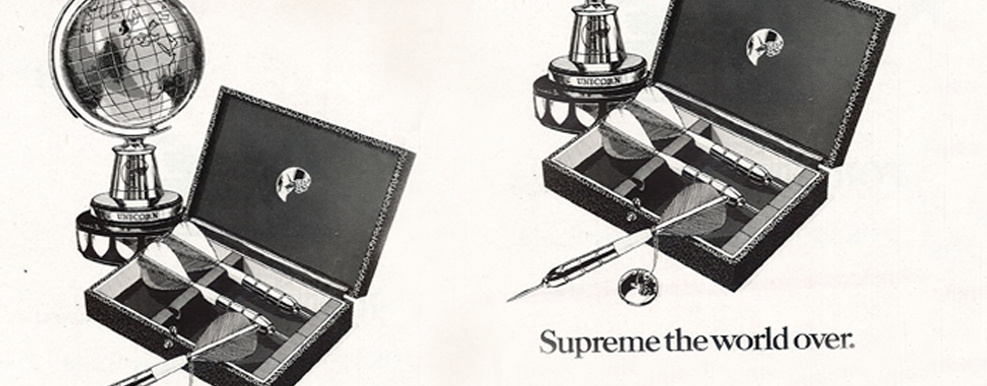A Short History of the Game of Darts

A Short History of the Game of Darts
- The Story
Even the most diligent research has failed, so far, to disclose any definite information as to the origin, or the early beginnings of the Game of Darts. It seems likely that it developed from the ancient art of throwing the spear or shooting the arrow and we can only conjecture that a long, long time ago some inventive genius, wanting to exercise his skill in a confined space, discarded his bow and shortened his arrow, thus creating the first dart.
The Oxford Dictionary traces the use of the word "dart", in its present sense, back to 1530, but it is not clear whether the darts of more than 400 years ago were used for sport or pastime. An early eighteenth century French print shows, however, two cherubs throwing, at a target, darts in which a shaft with flour flights wings at one end and a sharp point at the other are clearly discernible. It is pretty certain, therefore, that the game of darts has been known for at least 200 years.
The earliest dart probably consisted of a stick of wood or a piece of cane, some four inchees long and half inch in diameter, which had a shart point inserted in one end and had three or four feather wings stuck on the other end. In 1898 an American inventor patented the idea of the well-known folded paper dart flights, still in use today in some quarters. His dart consisted of a "shaft" with a point in one end and slots in the other end for the reception of the folded paper flight. In 1900 a British inventor suggested the application of a sheet metal ferrule to the pointed end of the shaft, to prevent it from splitting, and also the use of a slidable clip for gripping or releasing the paper flight inserted in the slotted end, another feature still with us today.
It will be seen that up to the beginning of the present century darts remained very primitive and that it was just 50 years ago that the possibility of improvements first engaged the attention of inventors. No doubt, at that time, the game begain gaining popularity and one wonders whether the well-known subdivision of the dartboard into sectors, with their ingenious method of numbering, was introduced then and was responsible for the rising interest in darts. No data are available as to the invention, or probable date of introduction, of the modern dartboard face, but whenever this happened, it must have given a powerful impetus to the game, as undoubtedly it necessitated the development of much greater skill than was required for hitting the early target, consisting of a surface marked with concentric rings.
It was not until 1906 that the first patent of an all-metal dart body was taken out by a Yorkshireman. During the next 30 years only fifteen applications were filed for patents in connection with improvements in the construction of darts and flights. The following 10 years, however, saw the birth of no fewer than thirty-seven inventions, or would-be inventions for darts, a sevenfold increase.
The records of the Patent Office constitute a fine barometer of the trend of events in practically every sphere of human activity and the history of the development of our society could almost be written by a shrewd appreciation of their pages. Thus, the increasing interest of inventors in darts is a reflection of the growing popularity of the game which, today, has reached phenomenal proportions. It is estimated that in the British Isles the game at present claims 4 million adherents, who are combined together in thousands of teams and clubs formed in every city, town, village and hamlet of the land. The teams and clubs being in turn organised in regional and national leagues, competing for local and national trophies and prizes. Thousands play regularly or occasionally in homes, social clubs, canteens, rest rooms and such like and the total number of people of both sexes and of all walks of life, who at one time or another succumb to the spell of darts, may far exceed the number estimated.
It is a well-recognised fact that interest in any form of activity increased with the improvement of the equipment for it. In this respect it is interesting to note that a turning point in dart design was reached in 1937, when the Silver Comet Precision Dart was patented by F Lowy. This was the first design which lifted darts out of the primitive stage, into the realm of precision engineering. A flood of would-be alternatives followed as a result of the success of the Silver Comet Dart, collapsible darts for the vest pocket, darts with variable weight, with removable points and such like were suggested in great variety, but it is abundantly clear that players do not like "gadgets", they prefer sound, well-made and reliable, but otherwise straightforward darts. Today the manufacture of first class darts has become almost a science.
Image Gallery

